Inspired by Zaph's 2.5-way MMTMM design, particularly its controlled directivity, and following a bulk purchase of some Seas P14RC/P OEM mid/bass drivers, what follows is the result of what I eventually did with them. It is a scratch build of my own which couples them with a modified Fountek NeoCD3 which I fitted with a corrugated pure aluminium ribbon in place of the original laminated one. The frequency response and distortion are almost identical to the original and the impedance is an ohm or so higher but resonance occurs at a lower frequency with a flatter hump. From what I have read about limited vertical directivity with an MTM configuration I also figured a ribbon tweeter might complement this nicely due to its own directivity characteristics.
Having never listened to a 2.5-way or an MTM or MMTMM and with no first hand experience of aperiodic enclosures I was going to 'push the boat out' with this design.
The outer '.5' units roll off early for baffle step compensation and their wider spacing hopefully extends controlled directivity inherent in MTM design further into the bass. Bass loading is aperiodic with a pair of vents on the rear. Crossover is at 3Khz which is a low as I dare to go with the ribbon tweeter and a 2nd order filter but just meets the rule of thumb guideline for maximum centre to centre spacing between mid and treble of one wavelength at crossover, in this case 4.5".
My guess is that these Seas OEM units may have been used in the Proac Studio 150 and Sonique 5.5. From reviews of these models they can reach well into bass when reflex loaded however my plan was to limit the bass but maximise it's quality with subwoofers talking over wherever necessary, thus the decision for aperiodic loading for its superior transient performance. Measurements of the drive unit parameters followed by simulations for aperiodic loading indicated bass rolling off at a fairly high 95Hz, though in room this eventually ended up at 85Hz and integrates seamlessly with the subwoofers adjusted accordingly.
The cabinets are 12mm MDF which is lined with 10mm slate and cross braced also with slate. Cabinets which I've built this way in the past have consistently sounded far more transparent and less coloured than MDF or ply, in fact I wouldn't consider building a serious loudspeaker without such a lining any more. Ceramic floor tiles work almost as well in my experience and as long as their surface is flat PVA adheres them very strongly and makes the job fairly straightforward. Crossovers are housed in a separate enclosure at the base with film/foil capacitors, air core inductors in the treble section and ferrite cored inductors in the bass. The granite plinth is absolutely necessary for stability with these extremely heavy and otherwise unstable cabinets. The front baffles have offset tweeters for a slightly tighter vertical centre to centre driver spacing and are mirrored.
The vents consist of two layers of gutter mesh with polyester compressed to a 12mm thickness between them. I will try different densities for the membrane one day but as the impedance is already pretty flat and they sound good I'm just enjoying listening to them for now.
Frequency and phase measurements for crossover design were taken at 50" distance at tweeter level. I measured the inner pair of bass/mids together, then the outer pair of 0.5 units together and treated the two measurements simply as two separate units for the purpose of crossover simulations. Phase tracking through crossover turned out very well as did the smoothness of the response. Below 200Hz the response graph is probably not to be taken too seriously due to room interactions, however this range is smoother than measurements of previous loudspeakers made in the same room. A benefit of offset tweeters is that the relative phase between tweeter and mid/bass can be adjusted with a little toe in or toe out though I haven't felt any need to point them anywhere else other than directly at the listening position.
To me these sound really good. I've lived happily with transmission lines, more happily ESLs and more recently some Jordan based full-range and two-way sealed designs, one of which was my own design and has its own thread on this forum, but within their limit these MMTMMs have the cleanest bass of any of the above coupled with the best smoothness. They are highly articulate and effortless with what I'd describe as accuracy through focus with large acoustic spaces and small intimate ones reproduced very convincingly. Any reservations I may had before hearing them were dispelled very quickly during listening and I would encourage anyone considering something similar to go ahead.
There is an idea in the back of my head for a WMTMW design using some Jordan JX92, Bandor 50 and similar ribbons which I have left over from other projects, but with the reduced driver radiating area (at best it would be half what it is in the above design) and hence higher cone excursion, coupled with a second crossover point, I'm not sure any improvement in intermodulation distortion and benefits from rigid cones would outweigh the drawbacks.
Having never listened to a 2.5-way or an MTM or MMTMM and with no first hand experience of aperiodic enclosures I was going to 'push the boat out' with this design.
The outer '.5' units roll off early for baffle step compensation and their wider spacing hopefully extends controlled directivity inherent in MTM design further into the bass. Bass loading is aperiodic with a pair of vents on the rear. Crossover is at 3Khz which is a low as I dare to go with the ribbon tweeter and a 2nd order filter but just meets the rule of thumb guideline for maximum centre to centre spacing between mid and treble of one wavelength at crossover, in this case 4.5".
My guess is that these Seas OEM units may have been used in the Proac Studio 150 and Sonique 5.5. From reviews of these models they can reach well into bass when reflex loaded however my plan was to limit the bass but maximise it's quality with subwoofers talking over wherever necessary, thus the decision for aperiodic loading for its superior transient performance. Measurements of the drive unit parameters followed by simulations for aperiodic loading indicated bass rolling off at a fairly high 95Hz, though in room this eventually ended up at 85Hz and integrates seamlessly with the subwoofers adjusted accordingly.
The cabinets are 12mm MDF which is lined with 10mm slate and cross braced also with slate. Cabinets which I've built this way in the past have consistently sounded far more transparent and less coloured than MDF or ply, in fact I wouldn't consider building a serious loudspeaker without such a lining any more. Ceramic floor tiles work almost as well in my experience and as long as their surface is flat PVA adheres them very strongly and makes the job fairly straightforward. Crossovers are housed in a separate enclosure at the base with film/foil capacitors, air core inductors in the treble section and ferrite cored inductors in the bass. The granite plinth is absolutely necessary for stability with these extremely heavy and otherwise unstable cabinets. The front baffles have offset tweeters for a slightly tighter vertical centre to centre driver spacing and are mirrored.
The vents consist of two layers of gutter mesh with polyester compressed to a 12mm thickness between them. I will try different densities for the membrane one day but as the impedance is already pretty flat and they sound good I'm just enjoying listening to them for now.
Frequency and phase measurements for crossover design were taken at 50" distance at tweeter level. I measured the inner pair of bass/mids together, then the outer pair of 0.5 units together and treated the two measurements simply as two separate units for the purpose of crossover simulations. Phase tracking through crossover turned out very well as did the smoothness of the response. Below 200Hz the response graph is probably not to be taken too seriously due to room interactions, however this range is smoother than measurements of previous loudspeakers made in the same room. A benefit of offset tweeters is that the relative phase between tweeter and mid/bass can be adjusted with a little toe in or toe out though I haven't felt any need to point them anywhere else other than directly at the listening position.
To me these sound really good. I've lived happily with transmission lines, more happily ESLs and more recently some Jordan based full-range and two-way sealed designs, one of which was my own design and has its own thread on this forum, but within their limit these MMTMMs have the cleanest bass of any of the above coupled with the best smoothness. They are highly articulate and effortless with what I'd describe as accuracy through focus with large acoustic spaces and small intimate ones reproduced very convincingly. Any reservations I may had before hearing them were dispelled very quickly during listening and I would encourage anyone considering something similar to go ahead.
There is an idea in the back of my head for a WMTMW design using some Jordan JX92, Bandor 50 and similar ribbons which I have left over from other projects, but with the reduced driver radiating area (at best it would be half what it is in the above design) and hence higher cone excursion, coupled with a second crossover point, I'm not sure any improvement in intermodulation distortion and benefits from rigid cones would outweigh the drawbacks.
Attachments
-
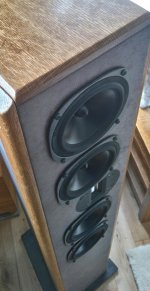 IMG_20190408_100248.jpg404.5 KB · Views: 484
IMG_20190408_100248.jpg404.5 KB · Views: 484 -
 IMG_20190408_100051.jpg295.2 KB · Views: 469
IMG_20190408_100051.jpg295.2 KB · Views: 469 -
 IMG_20190408_100517.jpg217.2 KB · Views: 470
IMG_20190408_100517.jpg217.2 KB · Views: 470 -
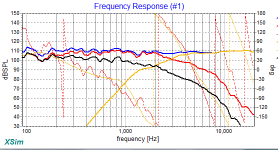 Tower simulation.PNG25.3 KB · Views: 467
Tower simulation.PNG25.3 KB · Views: 467 -
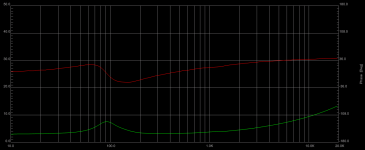 Aperiodic impedance sweep.PNG52.2 KB · Views: 451
Aperiodic impedance sweep.PNG52.2 KB · Views: 451 -
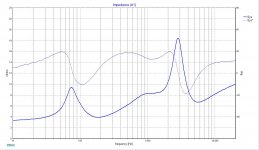 Tower impedance.jpg144.2 KB · Views: 161
Tower impedance.jpg144.2 KB · Views: 161 -
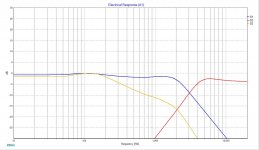 Tower transfer function.jpg140.3 KB · Views: 207
Tower transfer function.jpg140.3 KB · Views: 207 -
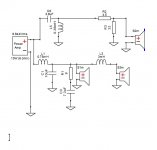 Tower Xover.jpg48.2 KB · Views: 257
Tower Xover.jpg48.2 KB · Views: 257
Last edited:
Thanks for sharing this! I saw your post about it in the other thread and was hoping you would make a thread for it 🙂
I'm curious - what made you think to line it with slate? Any thoughts as to the effect this has on the sound?
I'm curious - what made you think to line it with slate? Any thoughts as to the effect this has on the sound?
Thanks for the comment. Rather than write it here I've updated my original post to include the answer to your question.
Congratulations on a very interesting and well thought through design.
I am interested in the aperiodic aspect of it. How did you decide on the volume of the enclosure?
I am interested in the aperiodic aspect of it. How did you decide on the volume of the enclosure?
- Status
- Not open for further replies.